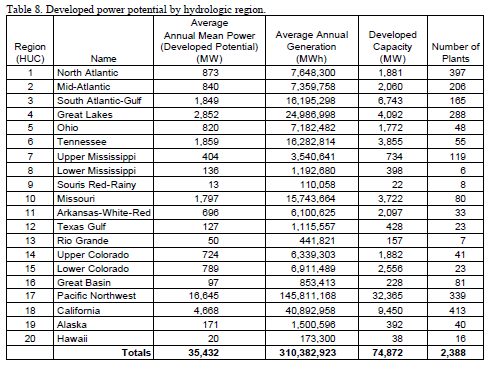Knowledge fuels change - Support energypedia!
For over 10 years, energypedia has been connecting energy experts around the world — helping them share knowledge, learn from each other, and accelerate the global energy transition.
Today, we ask for your support to keep this platform free and accessible to all.
Even a small contribution makes a big difference! If just 10–20% of our 60,000+ monthly visitors donated the equivalent of a cup of coffee — €5 — Energypedia would be fully funded for a whole year.
Is the knowledge you’ve gained through Energypedia this year worth €5 or more?
Your donation keeps the platform running, helps us create new knowledge products, and contributes directly to achieving SDG 7.
Thank you for your support, your donation, big or small, truly matters!
Difference between revisions of "United States of America Energy Situation"
***** (***** | *****) |
***** (***** | *****) |
||
| Line 163: | Line 163: | ||
| − | <div>The Alaska Region contains the largest total potential with its slightly less than 90,000 MW of potential, which is approximately 30% of the total power potential of the United States. The Pacific Northwest Region has the second highest amount of total potential with slightly more than 76,000 MW of potential. Together these two regions contain over half (55%) of the U.S. power potential. From the perspective of the largest percentage of total power potential that has been developed, the Great Lakes Region (66%) and the Tennessee Region (37%) are particularly noteworthy with the next highest regions being the Lower Colorado (23%), Pacific Northwest (22%), South Atlantic-Gulf (21%), and California (17%).</div><div><br/></div><div><br/> | + | <div>"The Alaska Region contains the largest total potential with its slightly less than 90,000 MW of potential, which is approximately 30% of the total power potential of the United States. The Pacific Northwest Region has the second highest amount of total potential with slightly more than 76,000 MW of potential. Together these two regions contain over half (55%) of the U.S. power potential. From the perspective of the largest percentage of total power potential that has been developed, the Great Lakes Region (66%) and the Tennessee Region (37%) are particularly noteworthy with the next highest regions being the Lower Colorado (23%), Pacific Northwest (22%), South Atlantic-Gulf (21%), and California (17%)."<ref name="U.S DOE: Water Energy Resources of the United States with Emphasis on Low Head/Low Power Resources">http://hydropower.inel.gov/resourceassessment/pdfs/03-11111.pdf (4.4 pg. 33)</ref></div><div><br/></div><div><br/> |
{| border="0" cellspacing="0" cellpadding="0" style="width: 700px;" | {| border="0" cellspacing="0" cellpadding="0" style="width: 700px;" | ||
|- | |- | ||
| Line 178: | Line 178: | ||
| <br/> | | <br/> | ||
|- | |- | ||
| − | | | + | | <br/> |
| Distribution of the low head...... | | Distribution of the low head...... | ||
|- | |- | ||
| − | | | + | | |
| power category......... | | power category......... | ||
|- | |- | ||
| − | | | + | | <br/> |
| power class.......... | | power class.......... | ||
|- | |- | ||
| Line 201: | Line 201: | ||
|} | |} | ||
<br/></div><div><br/></div><div><br/></div> | <br/></div><div><br/></div><div><br/></div> | ||
| + | |||
=== Solar power === | === Solar power === | ||
Revision as of 13:46, 21 March 2012
Overview
The United States of America | |||
| |
| ||
|
Capital |
Washington D.C 38°53'N 77°01'W | ||
|
Official language(s) |
None at federal level [a] | ||
|
Government |
Federal presidential constitutional republic | ||
|
President |
Barack Obama | ||
|
Total area |
9,826,675 km2[1] | ||
|
Population |
313,206,000 (2012)[2] | ||
|
Rural population |
55,700,625 (2011)[3] | ||
|
GDP (nominal) |
$15.065 trillion (2011)[4] | ||
|
GDP Per capita |
$48,147 (2011)[5] | ||
|
Currency |
United States Dollar $ USD | ||
|
Time zone |
(UTC- 5 to -10) Summer (DST) (UTC - 4 to -10) | ||
|
Electricity generation |
4,253.3 TWh/year (2009)[6] | ||
| Access to Electricity | ~100% | ||
|
Wind energy (installed capacity) |
43,635 MW (2011) [7] | ||
|
Solar Energy (installed capacity) |
3,954 MW (2011)[8] | ||
Energy situation
Energy in the United States of America are produced from a variety of sources. The primary source of energy in the United States is coal at .
Renewable energy sources
Hydropower
|
|
Existing hydroelectric plants and high head/low power water energy sites in the conterminous United States.[9]
|
|
Low head/low power water energy sites in the conterminous United States[10] |
| Low-head-low power water energy sites in Alaska | |
| Existing hydroelectric plants and high head-low power water energy sites in Alaska |
| Distribution of the low head...... | |
| power category......... | |
| power class.......... | |
| Summary of results of water energy recourse assesment of the United States | |
|
Total capacity of hydroelectric plants in the united states by >sizes< | |
|
total number of hydroelectric plants in the united states |
Solar power
Biomass
Wind power
Geothermal Power
Policy framework, laws and regulations
Institutional set up in the energy sector
Activities of other donors
References:
- ↑ "United States". The World Factbook. CIA. 2009-09-30. Retrieved 2010-01-05 (area given in square kilometers).
- ↑ U.S. POPClock Projection". U.S. Census Bureau. Figure updated automatically.
- ↑ http://www.tradingeconomics.com/united-states/rural-population-percent-of-total-population-wb-data.html
- ↑ United States". International Monetary Fund. Retrieved 2011-10-09.
- ↑ United States". International Monetary Fund. Retrieved 2011-10-09.
- ↑ http://www.energy.eu/stats/energy-electricity-production.html
- ↑ http://www.windpoweringamerica.gov/wind_installed_capacity.asp
- ↑ http://www.seia.org/galleries/pdf/SMI-YIR-2011-ES.pdf
- ↑ http://hydropower.inel.gov/resourceassessment/pdfs/03-11111.pdf (pg. 47)
- ↑ http://hydropower.inel.gov/resourceassessment/pdfs/03-11111.pdf (pg. 29)
- ↑ http://hydropower.inel.gov/resourceassessment/pdfs/03-11111.pdf (4.4 pg. 33)


























